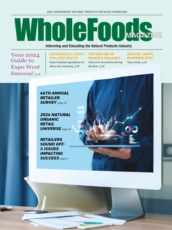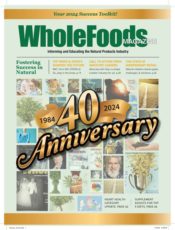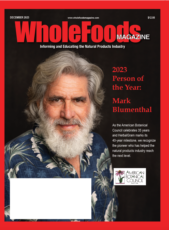
WholeFoods Magazine
Reduce, Reuse and Recycle...In That Order

In some pockets of the country, the word “recycle” has seemingly become a fallback, catch-all phrase, eclipsing the other two members of the eco-mantra trio: reduce and reuse. As I interacted with people dressed as the Bag Monster (www.bagmonster.com), a costume covered with 500 single-use plastic bags (what an average American is estimated to use in a single-year), I heard many saying “I use a recycle bag,” referring to their reusable bag. I knew what they meant, but at the same time, found the interchangeability of these terms alarming. The concept of recycling has been promoted heavily by environmental organizations, but even more vigorously by industry groups. Industry associations love the concept of recycling because it allows us “consumers” to consume all that we can, practically guilt-free. The sharp rise in the market success of single-use disposable products is direct result of the feel-good, go-green illusion of recycling and this is exactly why it promoted heavily and thus comes to mind first for many Americans.
The little chasing arrows icon on the bottom of plastic products is actually a clever scheme developed by the Plastics Industry to simply identify the various kinds of plastics, however most Americans believe these symbols mean the products can be recycled. Unfortunately, according to the EPA, less than 5% of plastics are actually recycled in the United States.
Because recycling is not a cure-all for consumption, it is actually supposed to be the last resort because the eco-mantra is in a specific order: REDUCE, REUSE and then RECYCLE. Unfortunately, industry doesn’t tend to promote reducing and reusing because the vast majority of business people believe these concepts are bad for business.
I found that as I crisscrossed the country, setting up my display of 45,000 single-use bags, the amount of bags the average American is estimated to use in a lifetime, people would stop, stare, take it all in and ask; “If not plastic, what bag am I supposed to use?”. The easy answer is simply a reusable bag. However, I found that this answer only addresses the “reuse” aspect of the mantra and doesn’t address the main issue.
What I have come to realize is that in our society, the single-use bag has become part of the purchasing ceremony and is typically given regardless of practical need. It marks the completion of a transaction, a non-verbal indication equivalent to, “Thank you for your purchase, enjoy the rest of your day, please step aside so I can help the next customer.”
So, upon seeing my display of 45,000 bags, I know, it is only natural for people to ask about a replacement bag. However, the best answer I found to the question is directed at reduction and goes something like this: Use no bag unless absolutely necessary, and if necessary, reuse a bag you already have. In America, based on my observations of and interactions with thousands of pedestrians, I estimate that we can realize an immediate and instantaneous 50% reduction in single-use bag consumption if each of us simply only took a bag only when we absolutely needed one.
This takes practice because cashiers are trained to close the transaction ceremony with a bag and you need to be alert in order to not receive a bag with your purchase. If you can easily carry an item in a hand, purse, backpack or pocket, say “I don’t need a bag, Thank you.” If you are shopping and already have a bag, it is certainly okay to use your existing bag for additional purchases. Double bagging–don’t allow it to happen. Two wrongs never make a right.
These three simple reduction efforts can make a big difference. I estimate a 50% reduction, which would eliminate 7 billion plastic bags from our waste stream annually in the United States alone. Reducing unnecessary plastics saves fossil fuel for better more productive uses, reduces litter and deadly plastic pollution in our communities, watersheds and oceans. I would love to hear how it works for you. If you find other easy ways to reduce single-use bags in your life, please join in with the conversation on Facebook/thebagmonster (www.facebook.com/thebagmonster).
 Andy Keller, entrepreneur and activist has traveled the country as the dreaded Bag Monster to increase support for single-use plastic bag reduction efforts. Keller is the Founder and CEO of the ChicoBag Company and a Founding Member of the Reusable Bag Industry Coalition.
Andy Keller, entrepreneur and activist has traveled the country as the dreaded Bag Monster to increase support for single-use plastic bag reduction efforts. Keller is the Founder and CEO of the ChicoBag Company and a Founding Member of the Reusable Bag Industry Coalition.
Blog posted November 9, 2010
"Recycle" has become a catch-all phrase that warrants some clarification.In some pockets of the country, the word “recycle” has seemingly become a fallback, catch-all phrase, eclipsing the other two members of the eco-mantra trio: reduce and reuse. As I interacted with people dressed as the Bag Monster (www.bagmonster.com), a costume covered with 500 single-use plastic bags (what an average American is estimated to use in a single-year), I heard many saying “I use a recycle bag,” referring to their reusable bag. I knew what they meant, but at the same time, found the interchangeability of these terms alarming. The concept of recycling has been promoted heavily by environmental organizations, but even more vigorously by industry groups. Industry associations love the concept of recycling because it allows us “consumers” to consume all that we can, practically guilt-free. The sharp rise in the market success of single-use disposable products is direct result of the feel-good, go-green illusion of recycling and this is exactly why it promoted heavily and thus comes to mind first for many Americans.
The little chasing arrows icon on the bottom of plastic products is actually a clever scheme developed by the Plastics Industry to simply identify the various kinds of plastics, however most Americans believe these symbols mean the products can be recycled. Unfortunately, according to the EPA, less than 5% of plastics are actually recycled in the United States.
Because recycling is not a cure-all for consumption, it is actually supposed to be the last resort because the eco-mantra is in a specific order: REDUCE, REUSE and then RECYCLE. Unfortunately, industry doesn’t tend to promote reducing and reusing because the vast majority of business people believe these concepts are bad for business.
I found that as I crisscrossed the country, setting up my display of 45,000 single-use bags, the amount of bags the average American is estimated to use in a lifetime, people would stop, stare, take it all in and ask; “If not plastic, what bag am I supposed to use?”. The easy answer is simply a reusable bag. However, I found that this answer only addresses the “reuse” aspect of the mantra and doesn’t address the main issue.
What I have come to realize is that in our society, the single-use bag has become part of the purchasing ceremony and is typically given regardless of practical need. It marks the completion of a transaction, a non-verbal indication equivalent to, “Thank you for your purchase, enjoy the rest of your day, please step aside so I can help the next customer.”
So, upon seeing my display of 45,000 bags, I know, it is only natural for people to ask about a replacement bag. However, the best answer I found to the question is directed at reduction and goes something like this: Use no bag unless absolutely necessary, and if necessary, reuse a bag you already have. In America, based on my observations of and interactions with thousands of pedestrians, I estimate that we can realize an immediate and instantaneous 50% reduction in single-use bag consumption if each of us simply only took a bag only when we absolutely needed one.
This takes practice because cashiers are trained to close the transaction ceremony with a bag and you need to be alert in order to not receive a bag with your purchase. If you can easily carry an item in a hand, purse, backpack or pocket, say “I don’t need a bag, Thank you.” If you are shopping and already have a bag, it is certainly okay to use your existing bag for additional purchases. Double bagging–don’t allow it to happen. Two wrongs never make a right.
These three simple reduction efforts can make a big difference. I estimate a 50% reduction, which would eliminate 7 billion plastic bags from our waste stream annually in the United States alone. Reducing unnecessary plastics saves fossil fuel for better more productive uses, reduces litter and deadly plastic pollution in our communities, watersheds and oceans. I would love to hear how it works for you. If you find other easy ways to reduce single-use bags in your life, please join in with the conversation on Facebook/thebagmonster (www.facebook.com/thebagmonster).
 Andy Keller, entrepreneur and activist has traveled the country as the dreaded Bag Monster to increase support for single-use plastic bag reduction efforts. Keller is the Founder and CEO of the ChicoBag Company and a Founding Member of the Reusable Bag Industry Coalition.
Andy Keller, entrepreneur and activist has traveled the country as the dreaded Bag Monster to increase support for single-use plastic bag reduction efforts. Keller is the Founder and CEO of the ChicoBag Company and a Founding Member of the Reusable Bag Industry Coalition.
Blog posted November 9, 2010







